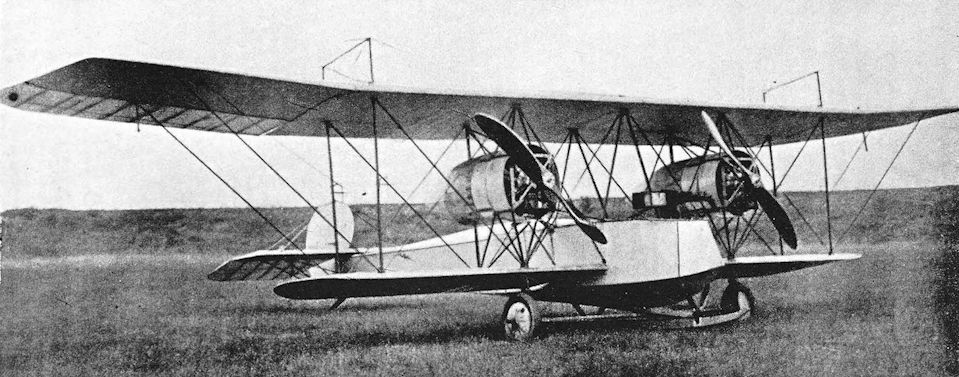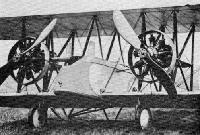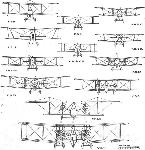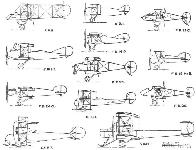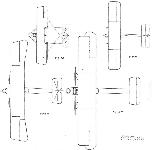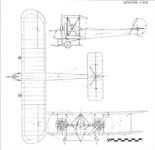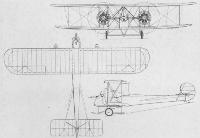C.Andrews Vickers Aircraft since 1908 (Putnam)
Shortly after the start of the first world war Vickers engaged Howard Flanders to design a new twin-engined fighting aeroplane to carry a Vickers one-pounder gun. Classified as the E.F.B.7, it was powered with wing-mounted Gnome monosoupape engines, and the pilot was seated behind the wings and the gunner in the nose. It flew some time in August 1915, and thus vied with the comparable French Caudron and other designs for the claim of being the first twin-engined military aircraft to fly successfully.
However, in the E.F.B.7 the distance separating the two-man crew was found unacceptable in practice; in the variant, the E.F.B.7A, the pilot was brought forward of the wings, just behind the gunner. An attempt to re-engine this Flanders-designed machine with two 80 hp air-cooled Renaults (because of the shortage of Gnomes) was unsuccessful, as the loss of some 40 hp meant a serious drop in performance. In consequence, a contract for 11 F.B.7 aircraft being built by Darracq and Company (1905) Ltd of Townmead Road, Fulham, was cancelled.
The E.F.B.8, which appeared in November 1915, powered by two Gnome monosoupapes, was smaller than its predecessor and carried only a single light Lewis gun, which could be accommodated equally well in single-engined types. This redesign was entrusted to Pierson, who stored the knowledge gained and revived it when a new twin-engined bomber was called for from Vickers by the Air Board in 1917.
E.F.B.7 E.F.B.8
Accommodation: Pilot and gunner Pilot and gunner
Engines: Two 100 hp Two 100 hp
Gnome monosoupape Gnome monosoupape
Span: 59 ft 6 in upper, 38 ft 4 in upper
37 ft 6 in lower 36 ft 8 in lower
Length: 36 ft 28 ft 2 in
Height: - 9 ft 10 in
Wing Area: 640 sq ft 468 sq ft
Empty Weight: 2,136 lb 1,840 lb
Gross Weight: 3,196 lb 2,700 lb
Max Speed at 5,000 ft: 75 mph 98 mph
Climb to 5,000 ft: 18 min 10 min
Ceiling: 9,000 ft 14,000 ft
Endurance: 2 1/2 hr 3 hr
Armament: One 1-pdr Vickers gun One Lewis gun
in nose in nose
Показать полностью
H.King Armament of British Aircraft (Putnam)
F.B.7. To provide an all-round field of fire for its Vickers 1-pounder automatic gun, this two-seat fighter, which appeared in the summer of 1915, was given two engines. No details of the gun mounting have survived, though it is said to have been bolted to the thick duralumin floor of the cockpit and would thus have differed in principle from that later described in connection with the F.B.24E. Nevertheless, the gunner's seat is said to have traversed with the gun.
F.B.8. Late in 1915 Vickers built this two-seat fighter, laid out generally along the lines of the F.B.7 but armed only with a Lewis gun. This was emplaced in the nose at the front of a narrow cockpit and appears to have had a restricted field of fire.
Показать полностью
P.Lewis The British Fighter since 1912 (Putnam)
While Harold Barnwell was busy designing the E.S.1 and E.S.2 for Vickers, another of the prominent British pioneer designers, R. L. Howard Flanders, was working for the same firm on a commission for a twin-engine machine capable of mounting a Vickers 1-pounder quick-firing gun. The designation F.B.7 showed that the new aeroplane was the next in line as a Fighting Biplane after the experimental F.B.6. The F.B.7 was the first design from Howard Flanders since his B.2 biplane of mid-1912 and was commenced just after the start of the War, following his enforced break with aeronautics after a serious motor-cycle crash and his subsequent recuperation far away in Australia.
The F.B.7, the first twin-engine aeroplane built by Vickers and among the earliest of multi-engine, two-seat gun-carriers, in general appearance displayed a very obvious connection with its designer’s earlier B.2. It inherited the same low-slung fuselage style, together with the deep fore-fuselage and triangular-section rear portion. The undercarriage, with its very wide track and prominent central skid also owed its inspiration to the B.2. Other features common to both were the outline of the comma-shaped rudder, lack of a fixed fin, and the braced overhang of the upper wings - a feature which was even more accentuated in the F.B.7.
A pair of 100 h.p. Monosoupape Gnomes, mounted starkly in the gap between the wings, powered the 59 ft. 6 in. span biplane. The pilot was seated in a roomy cockpit to the rear of the wings, a position from which his forward view was comparatively poor and which deteriorated still further when voluminous cowlings were installed later to shroud the engines. The bluff nose of the broad fuselage provided ample room for the large gun and enabled the gunner, whose seat was attached direct to the weapon’s mounting, to turn horizontally through a complete circle.
Following the F.B.7’s initial flight during August, 1915, it proceeded to the C.F.S. at Upavon for evaluation, which was followed quickly on the 20th of the same month for an order for twelve production examples.
Before work commenced on the batch, several significant alterations took place in the design. The most important of these was the location of the pilot’s cockpit in a greatly improved position forward of the wings and in a fuselage of greatly changed structure. Gone was the old triangular section at the rear and its place was taken by a conventional rectangular structure. A less happy change was the substitution of two 80 h.p. Renault engines as a result of a shortage of Monosoupape Gnomes. Designated F.B.7A and numbered 5717, the unwieldy machine was hard put to it to achieve any worthwhile performance on even lower power than that of its original engines, which themselves had been of far lower output than required to give the reasonable speed and agility to be expected in such a type. Vickers were left with little choice but to stop work on an altogether unsatisfactory combination and the War Office agreed to the annulment of the contract.
<...>
Following the unfortunate failure of their F.B.7 and F.B.7A, Vickers produced in November, 1915, another twin-engine tractor biplane gun-carrier. Once again, Monosoupape Gnomes of 100 h.p. each were fitted but, this time, the airframe which they powered was of far cleaner, more advanced and more compact design. The span was only 38 ft. 4 in. on the F.B.8’s upper planes of the two-bay wings, the lower surfaces of which were attached to the bottom longerons of the fuselage. The tandem cockpit arrangement, with a considerable gap between the position of the Lewis gunner in the nose and that of the pilot behind the wings, reverted to the form used in the F.B.7. The spinning rotary engines were liable to fling oil in all directions and the pair on the F.B.8 were surrounded by metal rings designed to mitigate the nuisance. The general lack of agility compared with that normally found in a single-engine fighter once again told against the F.B.8, as also did the gap between the crew’s positions, and so the design fell by the wayside.
Показать полностью
F.Mason The British Fighter since 1912 (Putnam)
Vickers F.B. 7
Designed under contract to Vickers Ltd by R L Howard Flanders (founder of a pioneering aircraft company which carried his name at Brooklands) and generally regarded as the first British twin-engine ‘fighter’, the Vickers F.B.7 was more accurately a gun-carrier, in the same context as the earlier Gunbus series. It was of most ungainly appearance, possessing large wing gap without stagger, but with considerable top wing overhang. This, and the mounting of rotary engines within the wing gap, resulted in a veritable maze of struts and bracing wires.
Designed to mount a one-pounder Vickers gun on the observer’s nose cockpit, the fuselage was of rectangular section at the forward end, fairing to inverted triangular section aft of the pilot’s cockpit below the trailing edge of the upper wing. The twin-wheel undercarriage possessed very wide track and a central skid. Twin kingposts extended above the upper wings in the plane of the outer interplane struts, supporting cable-bracing for the outer sections of the wing. There was no dihedral on upper and lower wing except on the overhang sections of the upper wing. Ailerons were only fitted on the upper wings and there was no fixed tail fin forward of the balanced rudder.
The prototype F.B.7 was powered by uncowled 100hp Gnome monosoupape handed rotaries, but these were enclosed in cowled nacelles soon after its first flight in August 1915. When, however, the War Office ordered a dozen aircraft it was found that these engines were in short supply and the production version, termed the F.B.7A, was to be powered by a pair of 80hp Renault V-eight engines - permitting a small reduction in the number of struts. Only one F.B.7A, which also featured a redesigned fuselage with the pilot’s cockpit moved forward of the wings, was completed, only to be discovered that the aircraft had suffered a substantial loss of performance due to the reduction in available power. Vickers, therefore, sought and obtained cancellation of the production contract.
Type: Twin-engine, two-seat, two-bay tractor biplane gun-carrier.
Manufacturer: Vickers Ltd (Aviation Department), Knightsbridge, London.
Powerplant: F.B.7. Two 100hp Gnome monosoupape handed rotary engines. F.B.7A. Two 80hp Renault V-eight engines.
Structure: Steel tubular construction throughout with ply and fabric covering.
Dimensions: Span, 59ft 6in; length, 36ft 0in; wing area, 640 sq ft.
Weights: (F.B.7). Tare, 2,136lb; all-up, 3,196lb.
Performance: (F.B.7). Max speed, 75 mph at 5,000ft; climb to 5,000ft, 18 min; endurance, 2 1/2 hr.
Armament: Single one-pounder Vickers quick-firing gun in nose.
Prototypes: One F.B.7 (flown in August 1915); one F.B.7A, No 5717. No production.
Vickers F.B.8
Whereas Vickers’ F.B.7 had been designed by Howard Flanders, the company’s second essay in twin-engine fighter design was undertaken by Reginald Kirshaw (‘Rex’) Pierson during the autumn of 1915, and the single example was flown that November. Compared to the F.B.7, Pierson’s aircraft was of extraordinarily compact design, its wing span being over 20 feet shorter and its all-up weight some 500lb less. Powered by the same 100hp Gnome monosoupape handed rotaries as the earlier aircraft, the F.B.8 was accordingly about 20 mph faster; these engines were encircled by oil slinger rings.
The wings of the F.B.8, being of only slightly unequal span, featured no significant overhang, so that untidy kingpost-supported bracing was superfluous and the strut arrangement was altogether tidier; ailerons were fitted to both upper and lower wings. The undercarriage and tail unit, however, remained much the same. The big one-pounder Vickers gun was discarded in favour of a Lewis gun on a spigot mounting forward of the observer-gunner’s bow position.
It is perhaps strange, however, that Pierson persisted in locating the pilot’s cockpit in the same position as in the original F.B.7 (under the trailing edge of the upper wing); the earlier design had been criticised on account of the distance between the two crew members, and communication between them would have been almost impossible during operational flying, and was much reduced in the F.B.7A.
Other than this assumed flaw, the F.B.8 was an ingenious and promising design which might have attracted official interest had not the introduction into single-engine tractor scouts of front gun interrupter gears not been imminent. Even so, as will be evident, Vickers persisted with pusher designs employing free-firing bow guns for some years. Pierson, on the other hand, was to call on his experience with the F.B.8 to produce his famous, much larger F.B.27 Vimy heavy bomber just two years later - an aircraft that bore more than a superficial resemblance to his twin-engine fighter.
Type: Twin engine, two-seat, two-bay tractor biplane gun carrier.
Manufacturer: Vickers Ltd (Aviation Department), Knightsbridge, London.
Powerplant: Two 100hp Gnome monosoupape nine-cylinder handed rotary engines driving two-blade propellers.
Structure: Steel tubular construction throughout with ply and fabric covering.
Dimensions: Span, 38ft 4in; length, 28ft 2in; wing area, 468 sq ft.
Weights: Tare, 1,840lb; all-up, 2,700lb.
Performance: Max speed, 98 mph at sea level; climb to 5,000ft, 10 min; ceiling, 14,000ft; endurance, 3 hr.
Armament: One 0.303in Lewis gun on nose spigot mounting.
Prototype: One (flown in November 1915). No production.
Показать полностью
W.Green, G.Swanborough The Complete Book of Fighters
VICKERS F.B.7 UK
On the outbreak of World War I, Vickers engaged R L Howard-Flanders to design a twin-engined fighting aeroplane capable of carrying a Vickers one-pounder quick-firing gun with armour protection for the gunner. Powered by two 100 hp Gnome Monosoupape nine-cylinder rotaries mounted overhung between the mainplanes and suspended on simple steel-tube open framework, the prototype was designated E.F.B.7 and was flown for the first time in August 1915. An ungainly unequal-span biplane with two bays of struts, the E.F.B.7 accommodated the pilot aft of the mainplanes, several feet from the gunner in the extreme nose. The substantial gun mount was bolted to the centre of the forward cockpit floor, the gunner’s seat being attached to the mount with which it traversed - sufficient room was provided in the cockpit to permit gun and gunner to turn through a full 360 deg. The E.F.B.7 was one of the first twin-engined military aircraft to fly successfully, and an order for 12 production F.B.7s was placed on 20 August 1915, immediately after the initial flight tests of the E.F.B.7, but, in the event, the series model was to differ in a number of major respects. The distance separating the two-man crew was found unacceptable and the pilot was brought forward of the wings in sensible proximity to the gunner, the structure of the upper wing was completely redesigned and the fuselage was revised in cross section, becoming rectangular throughout rather than having an inverted triangular cross section aft. Owing to a shortage of Gnome rotaries, the first production aircraft was fitted with 80 hp Renault eight-cylinder air-cooled engines as the F.B.7A, the engine change resulting in a major loss of performance. As the F.B.7A obviously possessed no operational usefulness, Vickers persuaded the War Office to cancel the contract for the remaining aircraft (which were being built by A Darracq & Company at Fulham under subcontract). The following data relate to the Gnome-engined E.F.B.7.
Max speed, 75 mph (121 km/h) at 5,000 ft (1525 m).
Time to 5,000 ft (1525 m), 18.0 min.
Ceiling, 9,000 ft (2 745 m).
Endurance, 2.5 hrs.
Empty weight, 2,136 lb (969 kg).
Loaded weight, 3,196 lb (1450 kg).
Span, 59 ft 6 in (18,17 m).
Length, 36 ft 0 in (10,97 m).
Wing area, 640 sqft (59.46 m2).
VICKERS F.B.8 UK
Although possessing a superficial resemblance to the F.B.7, the F.B.8. designed in the autumn of 1915 by Rex K Pierson, was a very much smaller, lightly-armed two-seat fighter carrying only a single 0.303-in (7,7-mm) Lewis gun as armament. Powered by two 100 hp Gnome Monosoupape rotaries, the F.B.8 began flight testing in November 1915, and performance proved to be good. The gunner was accommodated in the extreme nose and the pilot was seated beneath the trailing edge of the upper wing. From the outset, it was obvious that the armament carried by the F.B.8 could equally well be accommodated by a smaller, single-engined aircraft, but it had been hoped that an appreciably higher performance could be obtained by doubling the power available. Insufficient attention had been paid to the drag of such an aircraft, however, and performance proved lower than had been anticipated. Furthermore, the aircraft was insufficiently manoeuvrable for fighting duties and was discontinued.
Max speed, 98 mph (158 km/h) at 5,000 ft (1 525 m).
Time to 5,000 ft (1525 m), 10 min.
Service ceiling, 14,000 ft (4 270 m).
Endurance. 3.0 hrs.
Empty weight, 1.840 lb (835 kg).
Loaded weight, 2,700 lb (1225 kg).
Span. 38 ft 4 in (11,68 m).
Length, 28 ft 2 in (8,58 m).
Height, 9 ft 10 in (3.00 m).
Wing area, 468 sq ft (43,48 m2).
Показать полностью
J.Bruce British Aeroplanes 1914-1918 (Putnam)
Vickers F.B.7
THE Vickers F.B.7 was a contemporary of the E.S.1, and made its first flight in August, 1915. It was the first Vickers twin-engined type, and was designed as a heavy gun-carrier: its armament consisted of a Vickers one-pounder quick-firing gun mounted in the nose of the fuselage. The gun was tended by the occupant of the forward cockpit.
The F.B.7 was an ungainly biplane, characterised by a deep, low-slung fuselage of unusual design. The forward portion was of rectangular cross-section, but had a deep keel fairing. The bottom member of this fairing ran back to the stern-post, and the rear part of the fuselage was of inverted triangular cross-section. The pilot’s cockpit was situated behind the mainplanes, several feet away from the gunner.
The wings had two bays of struts, and only the enormous extensions of the upper mainplanes were rigged with dihedral. All interplane struts and engine bearers were of steel tube. The engines were two Gnome Monosoupape rotaries mounted midway in the gap between the wings, and rotating in opposite directions to neutralise torque reaction. The F.B.7 appeared with two different engine installations. In one case the engines were carried, completely uncowled, on overhung mountings; in the other they were encircled by casings designed to catch flying oil. In the latter case, fore-and-aft mountings were used, and the cowlings faired off into bulky nacelles of circular cross-section.
The tail-unit was conventional: there was no fixed fin, however, and the large rudder was a balanced surface.
The War Office ordered a dozen F.B.7s, and production had begun when it was learned that there was a shortage of Monosoupape engines. Vickers Ltd. were asked to fit two 80 h.p. Renault engines as substitutes, and at least one machine had that power plant. The arrangement of the interplane struts was altered from that of the prototype to accommodate the vee-eight engines, and a completely re-designed fuselage was fitted. It was a more conventional structure of rectangular cross-section, and the pilot’s cockpit was situated in front of the wings. The rigging of the mainplanes was slightly altered: the dihedral of the upper wings started at the inboard interplane struts.
The production version was re-designated F.B.7A. On test it was found that the loss of 40 nominal h.p. had proved so detrimental to the machine’s performance that Vickers Ltd. requested the cancellation of the contract. This was agreed, and no further development took place.
SPECIFICATION
Manufacturers: Vickers, Ltd. (Aviation Department), Imperial Court, Basil Street, Knightsbridge, London, S.W.
Power: Two 100 h.p. Gnome Monosoupape; two 80 h.p. Renault.
Dimensions: Span: upper 59 ft 6 in., lower 37 ft 6 in. Length: 36 ft. Chord: upper 8 ft 3 in., lower 6 ft. Gap: 7 ft 4 in. Stagger: 11 in. Dihedral: 3. Incidence: 3.
Areas: Wings: upper 459 sq ft, lower 181 sq ft, total 640 sq ft. Ailerons: each 46-5 sq ft, total 93 sq ft. Tailplane: 42 sq ft. Elevators: 28-5 sq ft. Rudder: 20 sq ft.
Weights and Performance (Gnome engines): Weight empty: 2,136 lb. Military load: 256 lb. Crew: 360 lb. Fuel and oil: 444 lb. Loaded: 3,196 lb. Maximum speed at 5,000 ft: 75 m.p.h. Climb to 5,000 ft: 18 min. Endurance: 2 1/2 hours.
Armament: One one-pounder Vickers automatic gun in forward cockpit.
Serial Numbers: The numbers 1616-1627, allotted for Vickers Fighting Biplanes other than F.B.5s, may have been for F.B.7s. They were ordered under Contract No. A.2614 (M.A.3). The F.B.7A was numbered 5717 and was ordered under Contract No. 87/A/39.
Vickers F.B.8
THE fighting success of the Vickers F.B.5 was ample proof of the effectiveness of a good aeroplane from which a machine-gun could be used in practical fashion, but it was obvious that better performance would be a great asset.
In an attempt to produce a gun-carrying aeroplane with the necessary performance the Vickers F.B.8 was built; to obtain the power needed, twin engines were fitted. As on the F.B.7, the engines were two opposite-handed Gnome Monosoupapes. For a twin-engined aeroplane the F.B.8 was remarkably small; and it was a much more business-like machine than the F.B.7.
The fuselage was a conventional structure in which the gunner occupied a cockpit in the extreme nose and the pilot sat behind the wings. The wide-track undercarriage was somewhat similar to that of the F.B.7, and had a large central skid. The two-bay wings were not quite equal in span, and the lower was of narrower chord than the upper. The engines were mounted in mid-gap; each was encircled by a ring to catch oil. The tail-unit was generally similar to that of the F.B.7: again there was no fin, and the single rudder was aerodynamically balanced.
The F.B.8 was built in November, 1915, and proved to be the fastest twin-engined aeroplane of that year. Despite its good performance, however, it was obviously too bulky to be effective as a fighting machine, and the distance between pilot and gunner was too great to allow of effective cooperation between them. The type was therefore abandoned, and the decision to do so was doubtless hastened or confirmed by the knowledge that the Vickers-Challenger interrupter gear then being tested offered a better prospect of providing effective armament.
SPECIFICATION
Manufacturers: Vickers, Ltd. (Aviation Department), Imperial Court, Basil Street, Knightsbridge, London, S.W.
Power: Two 100 h.p. Gnome Monosoupape.
Dimensions: Span: upper 38 ft 4 in., lower 36 ft 8 in. Length: 28 ft 2 in. Chord: upper 7 ft, lower 5 ft 9 in. Gap: 6 ft. Stagger: 10 in. Dihedral: 2. Incidence: 3.
Areas: Wings: upper 262 sq ft, lower 206 sq ft, total 468 sq ft. Ailerons: each 24-25 sq ft, total 97 sq ft. Tailplane: 35 sq ft. Elevators: 25 sq ft. Rudder: 13 sq ft.
Weights and Performance: Weight empty: 1,840 lb. Military load (including crew): 370 lb. Fuel and oil: 490 lb. Loaded: 2,700 lb. Maximum speed at 5,000 ft: 98 m.p.h. Climb to 5,000 ft: 10 min. Ceiling: 14,000 ft. Endurance: 3 hours.
Armament: One Lewis machine-gun on movable mounting in front cockpit.
Показать полностью
Jane's All The World Aircraft 1919
The Vickers E.F.B.7 a twin-engined fighter designed for Vickers by Howard Flanders. The engines were Gnome Monosoupape of 100 hp mounted between the wings.
It was designed to carry a Vickers one-pounder gun in the front, which made the arrangement that the gunner was in the front and the pilot way back behind the wings. The machine flew in August 1915. It was not succesfull and a modification was made (designation E.F.B.7A) where the pilot was placed directly behind the gunner. Also the engines were changed due to the scarcity of the Gnomes, making it far less powerful, so dropping the performance unacceptably. Only this one (5717) was built.
Vickers attempted another twin-engined fighter - the E.F.B.8 - but this did not work out either. The machine could be distinguished by the equal span wings, where the E.F.B.7 had unequal span wings.
Показать полностью
Журнал Flight
Flight, June 12, 1919.
"MILESTONES"
THE VICKERS MACHINES
The F.B. 7. (Aug., 1915)
The Vickers F.B. 7 was probably one of the first twin-engined machines to take the air. The, first flights were made in August, 1915. The power plant consisted of two 100 h.p. monosoupape engines, and the machine was designed to carry a Vickers 1-pdr. auto-gun. The Government looked upon the machine favourably, and ordered 12 similar ones. Information was afterwards received that the monosoupape engines were not available, and a request was made to substitute 80 h.p. Renault engines. This modification involved a considerable loss of power at a time when aeroplanes had little or no reserve. Realising that the machine would not be a success with the lower-powered engines, the Government was requested to cancel this contract, and this was accordingly done. The machine, however, will always be of interest as the forerunner of the now famous "Vimy."
The F.B. 8. (Nov., 1915)
In November of the same year, a smaller twin-engined machine was constructed to carry a Lewis gun, but it soon became apparent that the same armament could be more effectively employed with a similar engine, but a smaller and handier machine. The type, therefore, was speedily abandoned. It is of interest to note that this was the fastest twin-engined aeroplane in 1915.
Показать полностью
